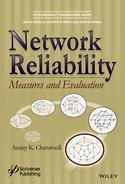Preface
The growth of reliability has assumed a new dimension in the recent years primarily because of the consequential impact(s) of failures of present day’s complex systems that may lead to day-to-day annoyance to the operational efficiency and uneconomical maintenance, and even to the extent of endangering life to our planet where a compromise with quality and reliability might be disastrous.
Although several books have been published in the area of reliability theory and practice, no book has been published on the topics covered in this book as the information presented in this book has either been confined to journals or given some space as a part of a chapter in a book. The topics covered in this book will interest not only the reliability community but also the teachers/educators and students of electrical, computer science, electronics, communication engineering with their allied areas. The text of this book is envisioned to be useful and can also serve as a one-semester course to senior undergraduate, graduate or postgraduate students in engineering. For researchers, practising engineers, managers, and designers, it would serve as a valuable reference and primer in the area of network reliability.
A very concerted effort has been made to keep the book ideally suitable for first course or even for a novice stepping into the area of network reliability. The mathematical treatment is kept as minimally as possible with an assumption on the readers’ side that they have basic knowledge in graph theory, probabilities laws, Boolean laws and set theory. A number of solved examples have been provided to make the topics pellucid with some exercises given at the end of chapters for readers to voluntarily test themselves and to have a better command of the material. The references provided at the end of each chapter are no way complete as no book of this size can claim to give a comprehensive survey of the subject spanning over a several decades. But they indeed serve as a platform and guiding factor for further research in this area.
In engineering theory and applications, we think and operate in terms of logics and models with some acceptable and reasonable assumptions. Reliability theory is not an exception where a rather popular model for studying and analysing computer/ communication/ transportation/ water/ electrical networks is as a probabilistic graph with a characteristic of edges and/or nodes subject to failures. The network reliability modelling and analysis is an important issue in system design, manufacture and maintenance, wherein the performance of a network depends upon the probability of a specified set of nodes being communicable or not being communicable. The popular measures of network reliability in vogue are 2-terminal reliability with or without capacity constraint on links, k-terminal and all-terminal reliability. The publications of hundreds of research papers in the last few decades on the assessment of such measures indicate the importance of this area.
Among the several approaches of network reliability evaluation, the multiple-variable-inversion sum-of-disjoint product (MVI-SDP) approach finds a well-deserved niche as it provides the reliability expression in a most efficient and compact manner. However, it does require an efficiently enumerated minimal inputs (minimal path, spanning tree, minimal k-trees, minimal cut, minimal global-cut, minimal k-cut) depending on the desired reliability. The present book is a maiden endeavour by the author to cover these two aspects in detail through the application of various techniques devised by the ‘reliability fraternity’ and could be its USP.
The author does not claim to be an ace programmer, and has provided very efficient and user friendly Matlab® programs which can be downloaded at www.scrivenerpublishing.com However, they are amenable to such modifications for the readers who love to do programming. The book is organized as follows.
Chapter 1 introduces the basic definitions, terminology, common assumptions with a broad category of techniques to tackle and evaluate network reliability problems. Chapter 2 succinctly provides the commonly employed hazard models and basic building blocks of a reliability block diagram. It describes a flexible Misra Matrix Method to solve a General series-parallel system reliability model consisting of various types of redundancies.
Chapter 3 pertains to the notion of network connectivity with respect to a specified set of nodes of the network graph termed as Minimal Path Sets, in general or 2-terminal, k-terminal and all-terminal minimal path sets, in particular. It describes several methods of enumeration to such requirement for measuring network reliability metrics. The chosen methods are simple enough for classroom teaching but become powerful once implemented on a computer using a suitable programming language.
Chapter 4 deals with the dis-connectivity criteria of a network reliability graph under a specified set of nodes termed as Minimal Cut Sets, in general or 2-terminal, k-terminal and all-terminal minimal cut sets, in particular. It also provides a general algorithm developed by the author to enumerate them. It also explains various sub-problems encountered in enumerations and their solutions thereof.
Chapter 5 discusses and describes Sum-of-Disjoint-Product based MVI approaches such as KDH88, CAREL, HM-1 and HM-2 to obtain and evaluate 2-terminal, k-terminal and all-terminal network reliability/unreliability measures.
Chapter 6 puts network reliability methodology and measures discussed in earlier chapters under a unified framework and extend 2-terminal reliability measure to link’s capacity-based reliability measure-CRR and describe a methodology to obtain the measure under such scenario.
In the last Chapter 7, the author has provided two case studies to show the approaches in action.
The author has tried his level best to make the text complete with logical flow and free of omissions. Nevertheless, as a student of reliability engineering, the author realises that ‘failures are inevitable and can never ever be predicted in advance, and cannot be eliminated’ but they and their consequences can definitely be minimized and mitigated. The author takes full responsibility for all those that still remain and shall be grateful if any such shortcomings or suggestions be brought to his notice.
Comments and suggestions regarding the book are most welcome and can be sent to [email protected].
Sanjay K. Chaturvedi
Kharagpur, India
March, 2016
